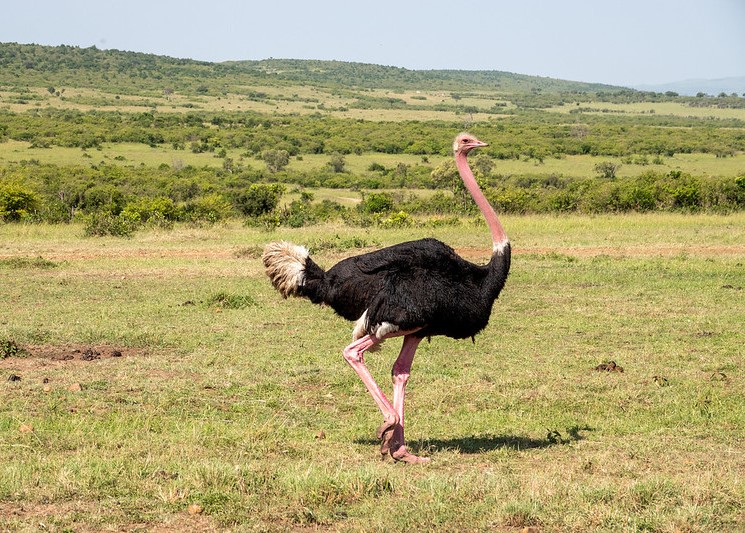The Big Five often steal the spotlight when it comes to safari conversations and photos, but there are plenty of lesser known animals that are worth watching out for, from the beautiful to the weird and wonderful. East Africa’s diverse wildlife includes a huge cross-section of breathtaking bird life, mammals and reptiles that can be seen on safari. Here are some of our favourite safari animals that didn't make the BIG Five.
Ostrich
The largest bird in the world, the flightless ostrich is only found in Africa. With an impressive plumage of feathers, it can grow to reach 2.75m, with its long neck contributing to almost half of this height! Ostriches are some of the fastest land animals in the world, and can achieve a speed of up to 72.5km. Ostriches live in semi-arid habitats across most of Africa. They are commonly found across East Africa and you shouldn’t have any trouble finding this spectacular bird during your safari in Tanzania, Kenya or Botswana.

Vulture
Despite their reputation for being the villains of the animal kingdom, vultures play an important role in many African ecosystems by scavenging the carcases of dead animals to prevent disease. There are a number of different vulture species residing across Africa, some of which are endangered, such as the Cape Vulture, which is estimated to have a wild population of under 10,000. Zimbabwe is a particularly great place for enthusiastic bird watchers to go on safari, with over 1,150 listed bird species. East Africa, particularly, the Serengeti & Masai Mara are also fantastic places to spot vultures. Powerful binoculars and a knowledgeable guide are great ways to ensure success. Vultures are usually spotted circling a carcass, high in the sky, so don't forget to look up.
Giraffe
The tallest animals walking the earth, giraffes can grow to almost 6 metres tall! The best way to spot them is to look above the trees. It is common to see giraffes in herds of up to 40 while on safari in East Africa and with no competition for grazing up that high, a giraffe can consume up to 30kg of leaves each day! While giraffes are listed as endangered, the Natural Resources Defense Council estimates that giraffe populations have declined 40 percent in the last 30 years. This is a worrying trend for what is our favourite African animal. The good news is that your chances of seeing giraffes on safari are high, especially on the plains of the Serengeti in Tanzania or Masai Mara in Kenya, however, if you want to catch a glimpse of baby giraffes, try planning your safari in early summer, around September.

Warthog
They may have faces that only a mother could love, but after Pumba's starring roll in The Lion King, warthogs are high on the list for many on safari. Said to be highly intelligent, warthogs get their name from the protective bumps or “warts” on their faces, and have short, curved tusks. They may be rotund, but a running warthog can reach speeds of up to 45km/hr! Warthogs are common across all East African national parks and reserves, but are particularly easy to spot at Zambia’s South Luangwa National Park.
Topi
These medium-sized antelopes are distinguished by their purple-brown coats with distinct black patches, and by their thick horns. They are usually found in floodplains across East Africa, but can also sometimes be spotted across open savanna and woodland areas. Tanzania’s Serengeti and Kenya's Masai Mara are great places to see large numbers of topi, especially during the Great Migration (November - May in Tanzania & June - October in Kenya).

Crocodiles
Also called Nile crocodiles, Africa’s crocodile population is widespread and can be found in rivers, lakes and marshland across Sub-Saharan Africa. They are smaller than Australian crocodiles, but no less impressive in the wild, particularly when animals make perilous water crossings during the Great Migration in the Masai Mara from June to October. Due to the Great Migration, Kenya is the best place to see crocodiles hunting or basking in the sun.
Agama lizards
Sometimes known as rainbow lizards because of the stunning bright colours across their scaly skin, agama lizards are brown or grey for most of the year, but in mating season males develop vibrant colours to attract females. Agama lizards can be found sunning themselves atop rocky areas across Tanzania, Kenya, Botswana, Namibia, & Zimbabwe. Agama lizards usually mate in the wet seasons, so this is the best time to catch their bright colours.

There are many other exotic animals across Africa and your safari guide will take great pleasure in pointing them out to you. Good guides also carry safari books that help you identify animals and provide a close up picture of them. A good guide will also have a good pair of binoculars that you can use.
Ready to start planning your african safari?
Check out our comprehensive guide to safari in Africa or book a consultation with an African safari experts to get an experts ideas and start planning your safari. Our private and custom-built luxury adventures are individually crafted to meet your wildest dreams! Secluded beach getaways, romantic safaris, honeymoon surprises, unique accommodation, or something a little weird and wonderful, tell us your wildest adventure dreams and we’ll make them a reality.